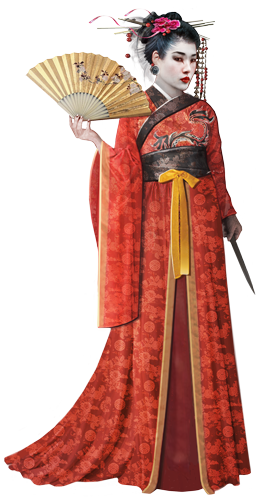- Home
- New To BattleTech?
- MUL
- Forums
- News
- Books
- Shrapnel
- Universe
- Downloads
- Characters
- Community
- Errata
- Links
- Gallery
Handbook House Kurita Developer’s Blog 5
On January 26, 2015
One of the biggest challenges to this particular book is trying to convey the arrogance of the Kuritas (as it’s from the perspective of a Combine historian) without sounding overdone and silly but still convey important information. The trick is to use the proper turns of phrase and word choice, which makes the entire process a tad challenging. By a factor of ten.
The only other option is a textbook-style read, which is, to be frank…BORING. With the difficulties this series already faces, I’ll do whatever I can to boost this last installment’s success.
Initial feedback from my reviewers has indicated I’ve been pretty successful in hitting that arrogant-yet-informative balance I want. Hopefully those who do read it in full will agree.
One of the things I love is the use of sidebars to help develop certain events that I determined needed a little extra ‘twist’ of perspective. Readers of the Wars of Reaving know exactly what I mean – sidebars are a great convention to communicate not just everyday snippets, but also differing points of view, alternate facets of a situation, or even ‘direct’ communication to show how something could have gotten misunderstood and warped into whatever action morphed from it.
I used sidebars in HBHK to help bolster the Kuritan sense of arrogance as well as culture, in addition to providing key little tidbits of ‘outside the text’ information.
I think it worked. Now, if the layout guy hates me for my overabundant use of them….then I know I’ve done my job well. 😀
Enjoy these short sidebars from various sections of the book.
The essence of religion is faith, a belief strictly independent of intellectual comprehension. Your religion, then, provides a complete ideological apparatus that is devoid of content. The content must come from elsewhere, from the reality of man’s interaction with the material universe. And because the state is the means mankind uses to mediate this interaction, the content of religion in every era must reflect the ideological requirements of the state that rules in that era and the leading class that controls that state.
—Analects and Commentaries of the Fifth Era; Sacred Works (O5P), 2817
 Women and Titles
Women and Titles
Through centuries of continued veneration of males and the subservience of females, titles and other practices use the male pronoun or imply the male gender. Even as these attitudes are slowly changing, centuries of tradition preclude any instant change of title structure. As such, though a planetary chairman may be a woman, she is still referred to as “chairman.”
—Kurita Etiquette Primer, Appendix A-2; Benjamin District Press, 3061
Non-Japanese Culture in the Draconis Combine
Although the general Kurita culture is closely based on that of Terran Japan, the majority of Combine citizens are not of Japanese ancestry. Especially on planets where one non-Japanese people predominates, there are definite strands of other cultures discernible.
The official Kurita tolerance for “foreign” cultures varies. At this time, under Jasmine Kurita’s advocacy of the arts, multicultural study and display is actually encouraged. The School of Cultural Investigation on Al Na’ir is dedicated to exploration of the different cultures “from which we took the best elements, to forge together the superior way of living known as Kurita culture,” according to Dean Hamin Gemal. Students of cultural investigation apply history, geography, anthropology, sociology, art history, and other disciplines to discover the hidden heritage of the non-Japanese Draconis Combine. The school even formed a task force in 3064, sending several instructors and researchers to observe and live in the Clan Nova Cat reserve areas.
While most cultural aspects—education, class structure, titles, and modes of address, for example—display the mainline Japanese-influenced culture of Kurita, arts and crafts on different planets still reflect the individual spirit and local cultural influences. For example, the architecture of the School of Cultural Investigation shows distinct references to the building style of the Terran Middle East and northern Africa.
Artists studying at Cultural Investigation, or influenced by its philosophy, follow their interests in one of two ways: reproducing the artistic forms of past times or adapting these forms to the present. Examples of the first include Philip Valenzuela’s translations of ancient Spanish authors—such as Marquez, Neruda, and Borges—and Marion Tsevernasky’s popular renditions of Russian, Ukrainian, and Martian folk music.
Examples of the adaptive school rank among the most exciting artistic work being done in the Combine today. The broad, cliff paintings of Bruno O’Leary are directly influenced by the Renaissance works of Monet, da Vinci, and Renoir. The neon kabuki performances by Isolde Gunnedottir reflect the mid-twenty-second-century, three-dimensional operatics of Jurgid and Tommes. Michi Kirosawa’s extremely popular trivid action cinema are directly influenced by the ancient monster telefilms of the Shōwa period.
The only major gap in the wave of interest in other cultures is that of the Azami people. Because of their unique status as allies of the Dragon rather than subjects, they are often viewed with a veil of mistrust. Some inroads have been made in trying to understand and elevate the Azami culture—especially to Kurita enclaves on Azami worlds and neighboring systems—but their own reluctance to open up their closed culture to outsiders has hampered efforts. The epic Sands of Fire, a harrowing tale of the Azami wildegort herders who helped the DCMS defend against a Davion raid on Dabih, is one of few current exceptions. Director Mohammed Lakhdar’s Second Succession War-era biopic has met critical success on several worlds, including Luthien and New Samarkand.
In the xenophobic atmosphere of House Kurita, the only way to sell the studies of other cultures is by stressing the superior way of the Combine and the benefits of incorporating the best of other cultures. It is likely that if Kurita suffers a major setback either internally or on the battlefronts, these foreign elements will be banned. Those studying these cultures know they are taking a great risk and, more than most, truly suffer for their art.
—The Struggle of Culture Amongst the Dragon’s Stars; Proserpina Press, 3066
Ben H. Rome
Assistant Line Developer







